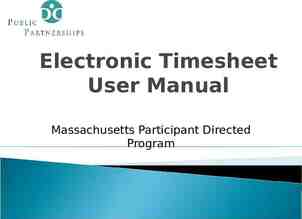Types of Early Childhood Programs Deborah M. Neill
17 Slides198.00 KB
Types of Early Childhood Programs Deborah M. Neill
After review of this presentation you will be able to . List and describe the various types of early childhood programs. Explain the advantages and disadvantages of each type of program. Name the three types of center sponsorship. Explain steps a parent may take in choosing quality child care.
Family Childcare Home The most common type of child care in the United States. Child care is provided in a private home. Most states require these homes be licensed. In a home where the caregiver has received early childhood training, a developmental curriculum may be planned.
Child Care Centers Facilities that offer full-day children’s programs. The focus of most of these centers is to provide care and education. In Colorado these facilities must be licensed. The care is designed to meet the child’s basic nutrition, health , and safety needs. The curriculum emphasizes the whole child including his or her social , emotional, cognitive, and physical needs. Most are open early in the morning and remain open until six or seven o’clock in the evening.
Montessori Schools Maria Montessori developed her own method of education. She is the first woman in Italy to receive a degree in medicine. Montessori established a theory of education which states that children learn best by being active. Montessori’s approach to learn was “learn how to learn”. This approach allowed the child to explore materials that were meant to instruct. Certain materials were given to the child in a prescribed sequence. The sequence was related to the child’s physical and mental development. Independence is stressed in Montessori schools. Children must learn to care for themselves. Teachers provide little help. Children learn through practical life experiences.
Head Start Federal funded government program for preschoolers designed to overcome the negative effects of poverty. Program provides child care and education for four and five year olds from low-income families. Head Start programs offer more than just education. Nutrition: the goal of the program is to help children make healthy food choices and develop good eating habits. Health: All children who attend are given a total health plan. Dental, medical, and mental health services are provided. Parental Involvement: Head Start recognizes the parent as the child's first teacher. Parents are encouraged to help recruit new children and assist in the center and take part in policy meetings. Parents are able to influence administrative decisions.
Kindergarten The first Kindergarten was opened in Germany. Kindergarten curriculum stressed play. Selfdevelopment takes place through play was the focus of the first Kindergarten. The first American kindergarten was opened in Watertown, Wisconsin in 1856. Today kindergartens are part of most public and many private school systems. They are usually restricted to children who are at least four years old.
Schedules There are three basic scheduling patterns in kindergarten: halfday, full-day and full day/alternating day sessions.
Goals Goals for a kindergarten program permit variety. Basic objectives of most kindergarten programs include: 1.Respect for the property, contributions, and rights of other children. 2.Development of positive feelings about school. 3.Development of a positive selfconcept. 4.Growth in language, social, and physical and creative skills. 5.Achievement of problem-solving and cognitive skills. 6.Development of independence. 7.Development of interpersonal skills. 8.Appreciation of objects of beauty.
Curriculum Kindergarten curriculum may vary from school to school. Kindergarten teachers, have more freedom in planning curriculum. Studies show that about 50% of the day is spent on creative activities.
School-Age Child Care Child Care programs provide care for children before and/or after school. Children from 5-10 years old most often attend. Children often do homework, play games, and take part in other activities in School-Age programs.
Laboratory Schools These schools are located on a postsecondary or college campus. They provide excellent programs for children but their primary purpose is to train future teachers and to serve as a study group for research. These schools have a highly qualified staff, a well-planned curriculum and excellent equipment.
High School Child Care Programs High schools that provide vocational training for child care occupations. These programs train future child care professionals. Many have their own child care laboratory facilities where students can work with preschool children. The preschool program may operate two or three days a week. High school students plan and present the curriculum under the supervision of a teacher. Some high school students observe the children while others work directly with the children.
Funding for Preschool There are three kinds of sponsorship: public, private, and employersponsored centers. Public Sponsorship are funded by federal, state, or local governments. Private Sponsorship are programs that are privately owned . They may be operated by a house of worship, hospital, or charitable organization. Many are nonprofit. Most private programs are operated by independent owners. Many of these centers are operated by families. Their motivation in operating a center is to provide a service that makes a profit. Employer Sponsorship-companies provide child care assistance so that employees have better work attitudes, new employees are attracted and community relations improve.
Selecting a Child Care Program Selecting a child care program is important for parents. Several factors influence selection of a child care program: cost, location, and type of program provided. Questions to ask when selecting Quality Child Care 1. Do the children appear to be happy, active, and secure? 2. Are all staff members educationally qualified? 3. Does the curriculum support the children’s individual rates of development? 4. Is the indoor and outdoor environment large enough to support a variety of activities? 5. Is the environment inviting, warm, and stimulating? 6. Are teacher-child interactions positive? 7. Are teachers using developmentally appropriate teaching strategies? 8. Does the climate in the center “”fee” positive/ 9. Do teachers meet with parents regularly to discuss the child’ needs, interest, and abilities/ 10. Is sufficient equipment available for the number of children attending?
Review Questions: Types of Early Childhood Programs Decide if the statement is true or false. During the first five years of life, children develop rapidly. Differences between early childhood programs are normal. Family child care programs vary according to the skills of the caregiver. Most child care centers provide care 24 hours daily. Montessori’s goal was to “learn how to learn.” In Montessori schools, children learn from sensory training. Nutrition is an important part of a Head Start program. The largest group of privately sponsored child care programs are those operated by churches. Provide complete sentences when answering the following questions or statements. List five questions parents should ask when selecting a child care program. What are some questions a parent should ask themselves when looking for a child care program? List three differences between a child care home and child care center.
Resources Types of Early Childhood Programs, Types of Early Childhood Programs Chapter 2 Test: copyright Goodheart-Willcox, Inc. Working with Young Children, Judy Herr: Copyright 2002, The Goodheart-Willcox Company, Inc.






















